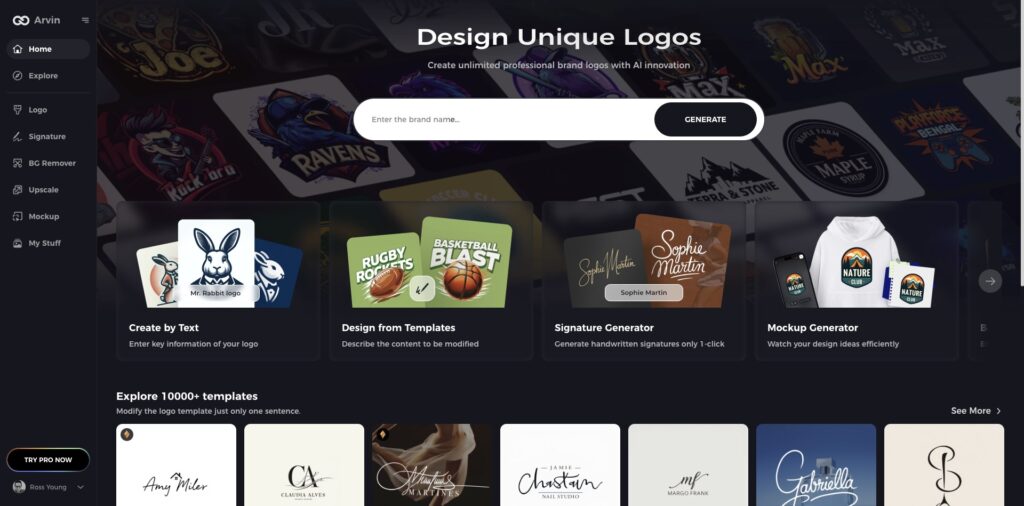
Effective social media branding leads to more engagement, increased follower numbers, and more income for your business. But how do you get it right?
Well, you can take a methodical, five-step approach to social media branding that ensures you cover all bases. There are also several ways that you can use Arvin’s latest AI tools to your advantage when implementing your social media strategy.
In this article, we explain the crucial role that your brand plays in your social media strategy and explain what social media branding is. We then take you through five straightforward steps you can follow to get your branding right.
But first, why is your brand so important, and what do you need to be aware of before posting on social media? Let’s investigate.
First: Why your brand is crucial
Jeff Bezos, the founder of Amazon, famously said, “Your brand is what other people say about you when you when you’re not in the room.”
I love this quote. It shows that you cannot completely control people’s perception of your brand. After all, you can’t control what others say about you.
But you can direct the narrative by building a positive, strong, and impressive brand on social media and other online channels.
If you’re consistent with your posting and work hard to build a good brand on social media, people are likelier to see it positively.
Your brand, then, is your personal or professional identity. It should be unique and powerful, rooted in your values, objectives, and passions.
The best brands are instantly recognizable and distinct. Just look at companies like Coca-Cola and Starbucks. Their brands are so distinct and uniquely positioned that they are globally recognized and renowned for quality and trust.
So, before you can master social media branding, you must start with the brand itself.
Five steps for creating or refining your social media branding

Launching a brand for your business is a creative process. If you already have a brand, you should perform an audit to check that it’s unique and engaging.
Whether you’re starting afresh or refining your brand, here are the steps you should take before implementing a social media branding strategy:
Step 1: Define your target audience
Before launching a social media campaign, you must start with your target audience. Why? Because if you don’t know who your brand is targeting, it’s impossible to know which messages to convey.
Given the global reach of social media, many marketers fall into the trap of assuming that their target audience is worldwide. But, for most brands, it’s impossible to market products and services to seven billion people!
Even global superbrands like McDonalds don’t promote their products in every global market. So, you must be specific with your target audience. Here are some things to consider:
- What geographic region are you targeting? If you’re based in North America, can you refine your customer base to a specific state or city?
- Are your target market within a specific economic bracket? For instance, are you a luxury travel or clothing brand? If so, you need to market to customers with a high level of disposable income.
- Which hobbies and interests do your audience have? Will these interests influence their buying decisions?
- How old is your ideal target audience? Are you targeting Gen Z? Are your products best suited to a specific gender?
When you answer these questions, you can create one or several brand personas, as explained below.
Creating a brand persona for social media
Creating a persona is an integral part of social media branding. It brings your target audience to life. For instance, rather than marketing to women in their twenties in the UK, you might promote your ethical, sustainably sourced bathing soap to the following persona:
- Mary is a 22-year-old white female living in London, UK.
- She is socially conscious and cares about climate change and sustainability.
- Mary makes conscious purchasing decisions and only buys from brands with environmentally friendly values.
- She cares about fair trade and is willing to pay above the market average for quality, ethically sourced produce.
- Mary is a vegan and cares deeply about animal welfare.
Though Mary is a very specific example, she works well for an ethical, natural soap brand in the UK. She would likely be one of the company’s most loyal customers, so the company’s branding should reflect her interests.
Many companies have several brand personas. While this can work, make sure they aren’t polar opposites. For instance, you shouldn’t pair Mary with Mike, a 40-year-old white male who cares nothing for climate change or environmental issues! Your personas should be similar, but they will probably target different segments of your prospective social media audience.
Step 2: Establish your branding guidelines
Branding guidelines should be the central aspect of your company’s brand package to ensure uniformity in your online messaging. You can learn more about the complete brand package here.
The good news about branding guidelines is that they don’t need to be complicated. Anyone can put together branding guidelines for a company. However, you must think carefully about the decisions that you make and how they portray your brand.
What to include in your branding guidelines
Below are the key components your branding guidelines should cover:
A logo
Your logo is the most crucial element of your branding guidelines. It should be the centerpiece from which all your remaining guidelines stem.
Therefore, subscribe to Arvin to use our outstanding logo generator today. Harnessing the latest in AI technology, our logo maker enables you to design unique logos with the click of a button.

You can also explore thousands of templates for inspiration. If you’re not happy with the initial logo, you can play around with the prompts to create something more aligned with your brand.
After using our logo generator, you will have a professional logo in seconds, which is the perfect start to your social media branding journey.
Typography
The font you use for your social media branding says a lot about your company. Think carefully about whether to use Arial, Times, Calibri or any other conventional font. You may prefer edgier, less commonly used fonts, which add a colorful element to your brand.
Whichever font you decide to use, list it in the branding guidelines. You should also include details relating to the font size and details for headings and sub-headings.
Tone of voice
The tone of voice is crucial, as it deals with how you interact with your audience. Do you want to adopt a playful and upbeat tone like McDonalds? Or, might you take inspiration from brands like Ryanair (the UK’s primary low-cost airline), who adopts a crass, sarcastic tone of voice?
For inspiration, check out 30 of Ryanair’s most savage social media roasts. The company is a master of its edgy, sarcastic tone of voice. And while it doesn’t work for all brands, the budget airline has got this tone of voice down to a tee!
On this note, you should relate the tone of voice in your branding guidelines to your company values and objectives.
If you’re an ethical company with sustainable values, your tone of voice should be positive, upbeat, and uplifting. It wouldn’t make any sense to adopt a tone of voice similar to Ryanair in this example!
Color scheme
Next, decide on your brand’s color scheme. Branding colors are evocative and extremely important. You should specify which primary colors to use in your branding, including any slight variations for different mediums (i.e., ruby red on social media and maroon on your website).
It’s also a good idea to indicate which color your text should be and which colors to use for captions, borders, and social media graphics. The devil’s in the details, so be as specific as possible to ensure that all team members know which colors to use when posting.
Messaging, imagery, and graphics
Another key consideration for your social media branding is what messages, imagery, and graphics to include on your socials. Again, be specific. You might use one form of messaging on Instagram and another on LinkedIn.
This is also where you should include details of your company tagline or any words or phrases you want to avoid using on social media.
As for imagery, consider what type of images to share on your socials. Will you use stock images? Do you want to post user-generated content? Do you want to post sepia or black-and-white shots?
Consistency is crucial when posting on your socials, and the posts on your feeds should look similar. It doesn’t make any branding sense to jump between styles on social media, so be clear and concise about the types of posts you want to appear on your feeds.
For further insight into branding, read our recent post on how to create your own branding guidelines, drawing inspiration from top brands like Netflix and Nike.
Step 3: Work on your content strategy
Another crucial aspect of social media branding is your content strategy. Your content must resonate with your target audience and meet the branding guidelines you have just established.
Variety is key when considering which content to put out into the world. So, we recommend some or all of the following:
Photos & image-based content

Statistics show that visual content receives 94% more attention than text-only content on social media. This indicates the need to prioritize visual content on your socials.
Be specific with the type of images you share on your timeline. For instance, if you run a coffee business, you might want to share images of your own coffee being roasted, ground, and brewed rather than stock images of coffee.
But if this is the case, do you want to use professional photos? Or do you trust your staff to take photos on their phones, which they will then upload to your socials? You need to decide.
You should also consider what other image-based content to include on your channels. Infographics tend to work really well and are a better option than snippets of text showing statistics.
Also, ensure that your images are of a good resolution and fit the social media channel in question. Check out the sizing guidelines for Instagram and Facebook, and note how they are different. You can include these details in your branding guidelines.
Videos
95% of marketers agree that videos are an integral part of social media campaigns. Today, short-form videos in the form of reels work particularly well due to the limited attention span of most people.
Therefore, you should work short videos into your social media posting strategy. Create videos that show your brand in action. Followers love behind-the-scenes content, which works particularly well as the basis for reels.
As with images, ensure that your videos are professional and high quality and note any guidelines that you want your staff to follow when creating such content for your socials.
Text – captions & blog posts
Though text-based content doesn’t do as well as images and videos, it’s still an important part of your social media branding. You need to create captions for all posts as a starting point. The captions should match your intended tone of voice and be short and snappy.
We also advise you to invest in blog posts. Blog posts are ideal for longer-form content, which you can post on your website. You can then drop a link to the blog post in your social media captions to drive traffic to your website.
Aim for at least one blog post per week to keep your followers engaged and to encourage people to visit your site. If you can’t find the time to write blog posts, sign up and use our free online AI article writer powered by GPT-4o.
When using AI for your content, we advise you to review and personalize the text before posting it. This is a crucial step in ensuring that the content is well-suited to your audience.
Step 4: Decide which social media platforms to use
It’s now time to think about which social media platforms to use to reach your audience. According to the latest research:
- Snapchat, TikTok, and Instagram are the most-used platforms among 18-29 year-olds.
- LinkedIn, X (Twitter), and Instagram are the best platforms for reaching 30-39 year-olds.
- Facebook, LinkedIn, and Pinterest are the best platforms for marketing to 50-59-year-olds.
While these insights are a good starting point for choosing the most suitable social media platform for your demographic, you need to dig a little deeper.
The same research confirms that Facebook is the best overall platform for marketers, with over three billion users and an average use time of 30 minutes per day. Facebook has over one billion more users than Instagram and 1.3 billion more than TikTok, evidencing its impressive reach.
However, if you’re trying to engage with Gen Z, TikTok is a must, with 78% of the platform’s users within this demographic. Moreover, the average use time per day on TikTok is almost one hour, highlighting that people spend more time watching videos.
Interestingly, X (formerly Twitter) saw a 13% decline in users following its rebrand and now has just over 368 million users. Moreover, the text-based style of X means that it’s not the best option for marketers.
When deciding which platforms to use, don’t stretch yourself too thinly. It’s better to master one or two platforms than to post content sporadically on five or six. So, consider which platforms your target audience uses the most and select one to three to maintain as part of your social media branding strategy.
Step 5: Operationalize your social media branding campaign
The final step is to operationalize your plan. We recommend bringing all the people involved in your marketing together in a meeting at this stage. Whether you have one or two marketers or an entire department, it makes sense to agree to the plan together. At this stage, follow these crucial steps to get your social media branding campaign up and running:
1: Agree to the branding guidelines
Begin by sharing the branding guidelines. Feel free to ask for suggestions and recommendations and refine the guidelines if necessary. Make sure all members of the team are aware of the new guidelines and get them to agree to them before proceeding.
2: Develop a content plan
The most time-consuming element of rolling out a social media branding campaign is creating the content. You may have in-house creatives to do this work, or you might need to outsource the content to freelancers. Either way, develop a content plan that encompasses the following:
- Enough visual content for one month’s worth of social posts.
- Sufficient video content to mix things up.
- Blog posts and caption texts for all posts.
It’s entirely up to you how often you post, but consistency is key. We recommend somewhere between one and five social media posts per week to get started. You can always increase or decrease the amount you post as you refine your strategy.
If you can, create the content at least one week or even one month in advance. This ensures you have enough content in the bank and means you’re not scrambling at the last minute to find something to post.
3: Establish a social media posting calendar
We touched on it above, but you need to decide when and how often to post. Research shows that Tuesdays, Wednesdays, and Thursdays are the best days to post on social media for engagement. Sundays tend to be the worst.
Therefore, it makes sense to target these days in your initial calendar. You should also think about the time of your posts. For most businesses, it makes little sense to post in the middle of the night, but every business is unique, and you should research your own prime time.
Once you’ve decided on a posting schedule, you can use a tool like Later to automatically publish your posts. Give each team member their own login credentials and provide a tutorial on how to use it if necessary.
4: Monitor, review, and refine your approach
As you start posting, don’t sit back idly. The most successful social media branding campaigns and strategies are refined and improved over time.
Don’t assume that you’ve hit the sweet spot right away. Decide which KPIs to monitor and consistently review your approach to social media posting.
If you’re not hitting your targets, don’t be afraid to mix things up. Change the type of posts you put out into the world, and consider changing the time and days of your posts.
The bottom line: Improve your social media branding today
Professional and consistent branding is crucial for social media strategy success. No matter what type of business you’re promoting, you must establish some guidelines before sharing posts with the world.
As we’ve illustrated throughout this article, social media branding isn’t difficult to get right. Still, you need to work through the five-step process and ensure that all team members are on the same page.
Provided you’re willing to adapt and refine your social media branding, you should enjoy social media success this year.
Are you keen on more branding tips for your company this year? Read through Arvin’s 2025 Brand Bible for more tips, tools, and resources to grow and promote your brand like a pro.
Social media branding FAQ
What is social media branding?
Social media branding is the act of establishing and promoting a strong and consistent brand across social media. Rather than a scattergun approach, it requires consistency, professionalism, and consideration from all marketers. Posters must follow branding guidelines and ensure their content is thematically aligned with the brand’s values and objectives.
How do you promote your brand on social media?
There are many ways to promote your brand on social media. However, the best way is to create branding guidelines that all marketers can follow. You must also select the best platforms for reaching your target audience and post regularly and consistently. The best social media branding campaigns are also refined and improved once feedback is available.
Which social media platform is best for branding?
Ultimately, all social media platforms can be good for branding. However, your choice depends on your target audience and your overall objectives. That said, if we had to recommend one platform, it would be Facebook, given that it has the biggest user base of all the social media platforms in the world.


